Highlights
- The share of mothers with young children working part time has remained steady, at about 15%, since at least 1980. Post This
- We found that moms who work from home spend significantly more time with their young children compared to moms who work in-person. Post This
- Between 2019 and 2023, the share of moms working mostly in-person decreased by 7 percentage points, while the share working mostly at home rose by 7 percentage points. That’s a change of nearly one million mothers. Post This
Remote work is here to stay. While the technology that makes remote work possible has been around for some time, COVID accelerated its widespread adoption. The characteristics of the rising work-from-home class are well documented. They tend to be white-collar workers and earn higher wages, both within and across occupations. But we know less about the impact of remote work on home life. As Jon Askonas and Michael Toscano note, new technologies have a profound impact on the family. From the machines of the industrial revolution which drew labor out of the household, to the automobile which further sequestered the home away from production, technology has consistently disrupted older family arrangements and made way for new. Remote work is no different.
Over the course of the 20th century, more mothers with young children have moved to working outside the home as a result of social, economic, and technological developments. The share of moms with young children in the labor force rose from 8% in 1940 to over 60% by 2000. Following a brief lull in the 2000s, that number had risen to 68% by 2024. This growth has been, by and large, a rise in women working full time. The share of mothers with young children working part time has remained steady, at about 15%, since at least 1980.
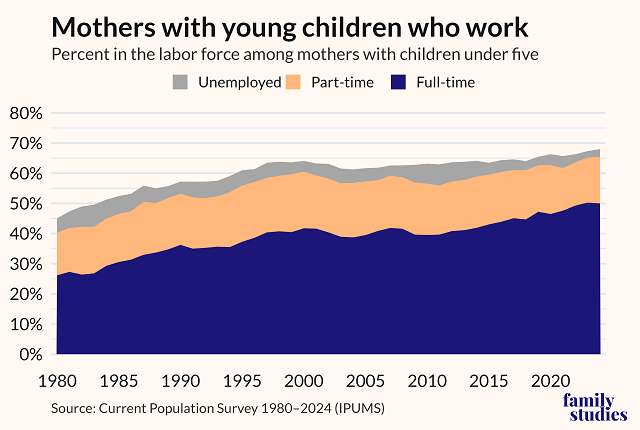
The pandemic did not reverse the trend of increased labor force participation. Between 2019 to 2024, the share of mothers with young children working full-time rose by nearly three percentage points (from 47% to 50%). This was accompanied by a slight decline in unemployment, and a 2.5 percentage-point decline in those not in the labor force. Strikingly, the pandemic does not appear to have inflected this long-term trend. Indeed, the share of full-time work among mothers of young children has risen, on average, by 2.8 percentage points every five years since 1980.
What has changed, however, is where mothers work. Between 2019 and 2023, the share of mothers working mostly in-person decreased by 7 percentage points, while the share working mostly at home rose by 7 percentage points. That’s a change of nearly one million mothers moving from in-person to remote work. It is in this that we begin to see how remote work is changing the modern household.
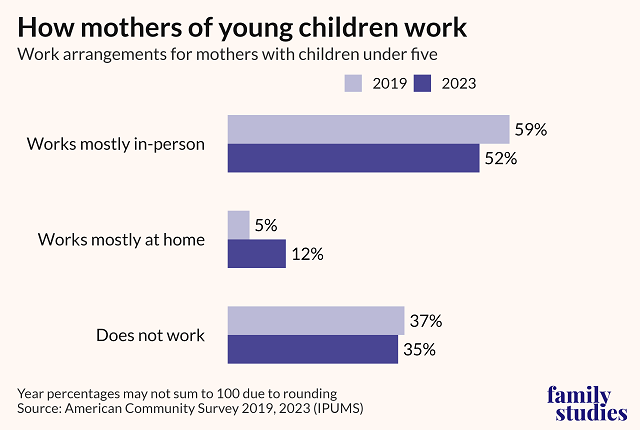
It’s no secret that full-time working mothers spend less time with their children. The tug between kids and the workplace is, for many career-minded moms, taxing to navigate. But where a mom works makes a big difference, as we found in our analysis of the American Time Use Survey (ATUS), which asks Americans how, and with whom, they spent the prior day.
Specifically, we found that moms who work from home spend significantly more time with their young children compared to moms who work in-person.
Mothers with young children who worked full-time outside the home spent the plurality of their time—6 hours—with co-workers, colleagues, or clients, and just under 4 hours with their children. Mothers working full-time but from home spent, on average, over 6 hours with their own children. Working part-time or not working still resulted in the most time with one’s own children, at about 8 and 10 hours respectively.
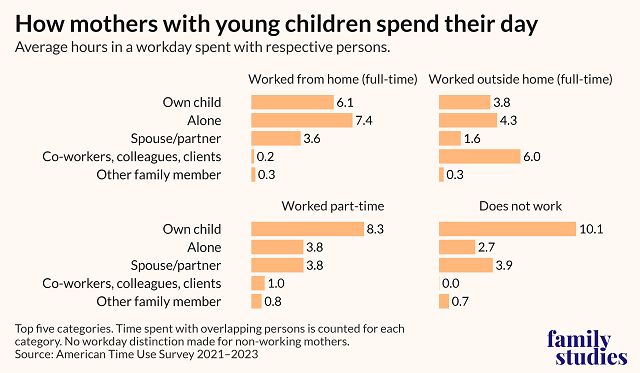
These differences held up even across a range of demographic factors such as income, education, age, marital status, and partner employment. When we controlled for these factors, we found that those mothers with young children who worked full-time from home spent 2.4 additional hours with their children on a given workday compared to those who worked full-time outside the home. Mothers of young children who worked part-time spent 4.6 more hours with their children, and those who did not work spent 6.3 more hours with their children compared to those who worked full-time outside the home.
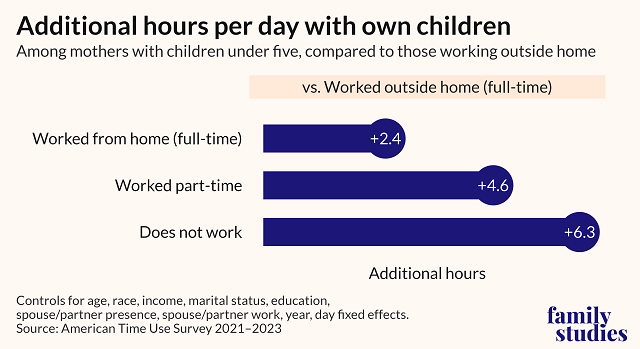
The Benefits of Remote Work for Moms
More Family Time. The additional 2.4 hours per workday that remote working moms spend with their young children is a social good that can’t be ignored. We know that time spent away from parents for very young children is associated with negative long-term outcomes and that the mother-infant attachment is massively important for the child’s social-emotional development. We also know that spending time with one’s own kids is important for a mother’s happiness. In a world where more mothers of young children are in the workforce, the remote work option affords these moms more time with their infants and toddlers.
Flexibility. Remote work also gives working moms more flexibility. When we look at the distribution of hours spent with one’s own children, we can see that working from home allows a wider spectrum of time spent with children. Although mothers who worked from home most often spend 3-5 hours with their children, there is a long tail to the right of the distribution, meaning many of those mothers spend much more time with their children. Compare this to mothers who worked in-person, which hits a wall at about six hours.
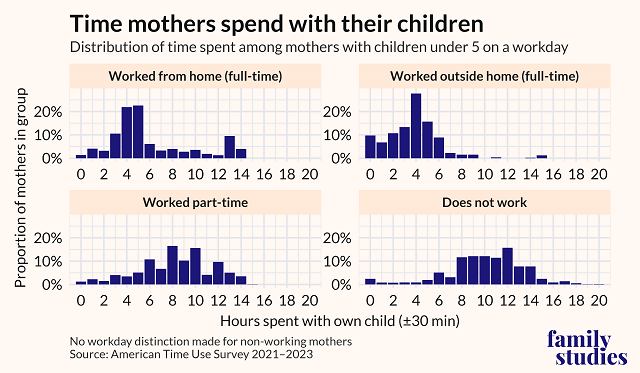
Resilient Families. Remote work has other familial benefits. The flexibility from remote work allows a family unit to better handle the shock of the inevitable but unpredictable shocks of family life and generally operate more smoothly. Parenting and household management is full of variable and often unpredictable demands on time. Poor health or family loss can pop up at a moment's notice. The additional time and flexibility afforded to remote working moms not only adds to the emotional health of the mom and baby, but also supports the structural health of the household, allowing families some slack when the inevitable surprises of family life appear.
Now, we do not claim that remote work is without drawbacks. Working remotely might mean missing out on the career benefits, and wrangling a toddler while on the job can lead to a constant juggle of responsibilities. And on a broader scale, remote work may contribute to social atomization and feelings of transient placelessness. For many occupations such as healthcare and teaching, remote work is simply not an option. Even so, remote work is presently allowing millions of mothers with young children to help support their families while being present to their infants and toddlers. Technological change has often been, historically, injurious to the family. But for many, remote work is a welcome exception.
Nicole Ruiz (@nwilliams030) is a homemaker and mother who angel invests and writes about technology, family, & community. Grant Bailey is a Research Associate with the Institute for Family Studies.













